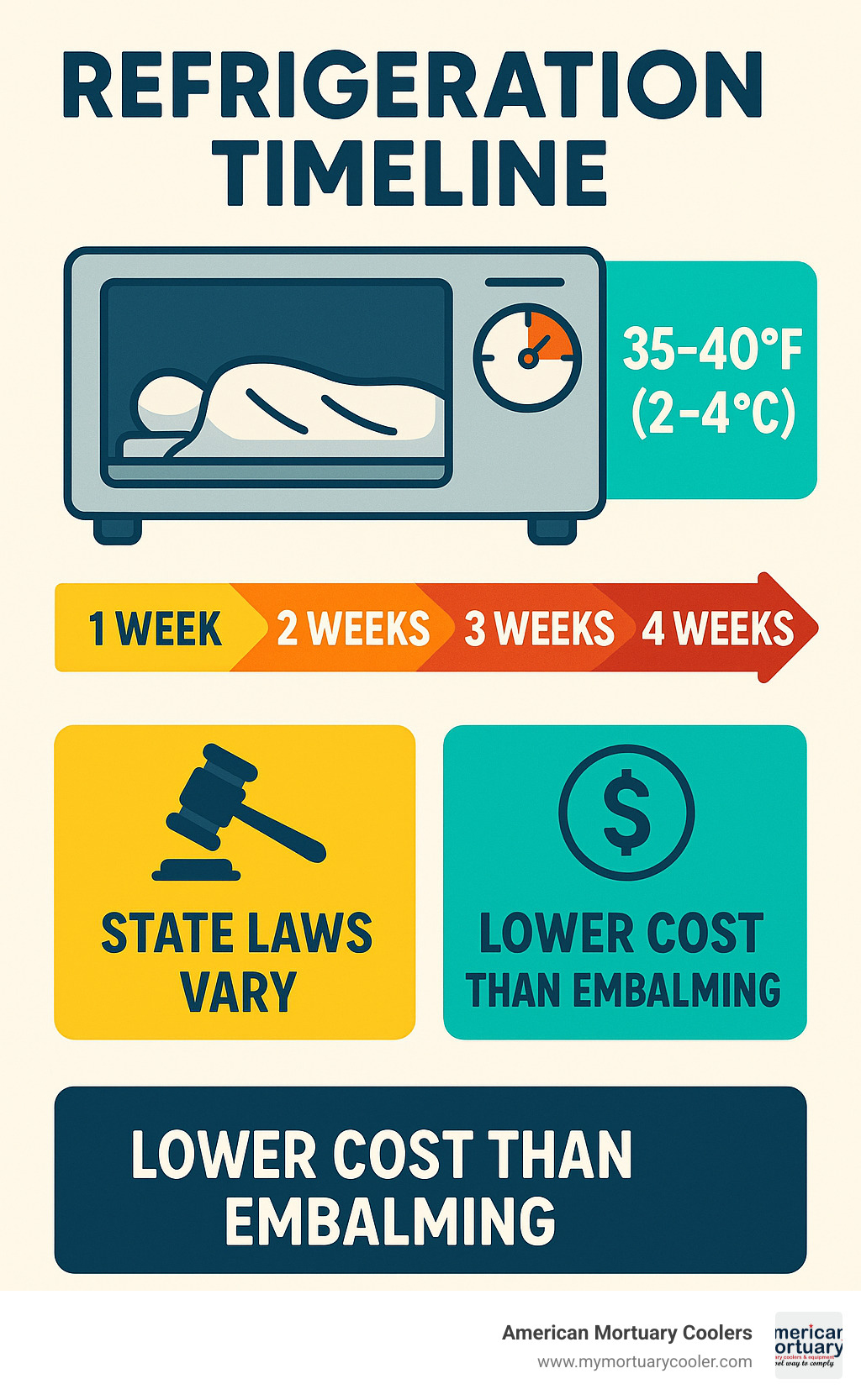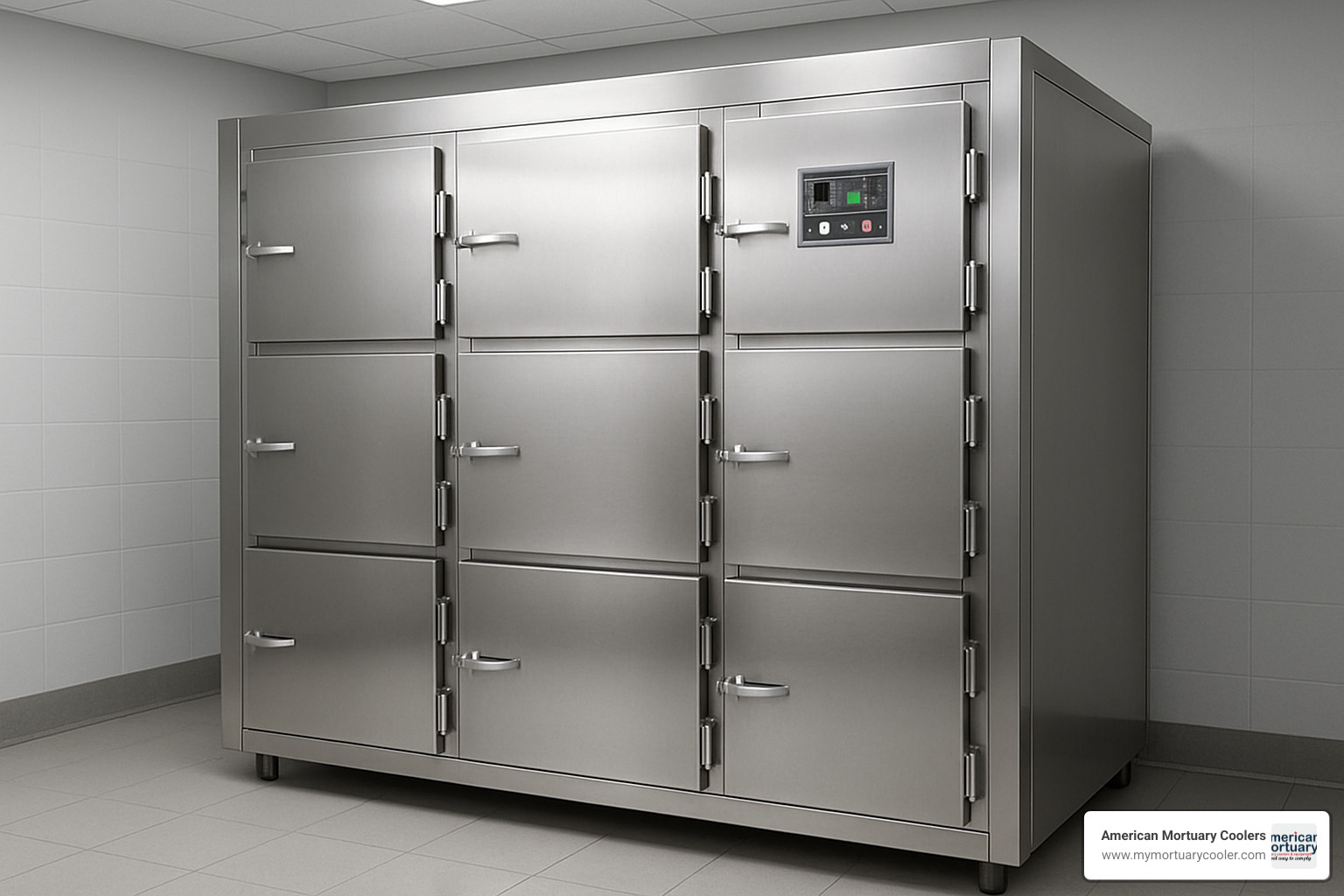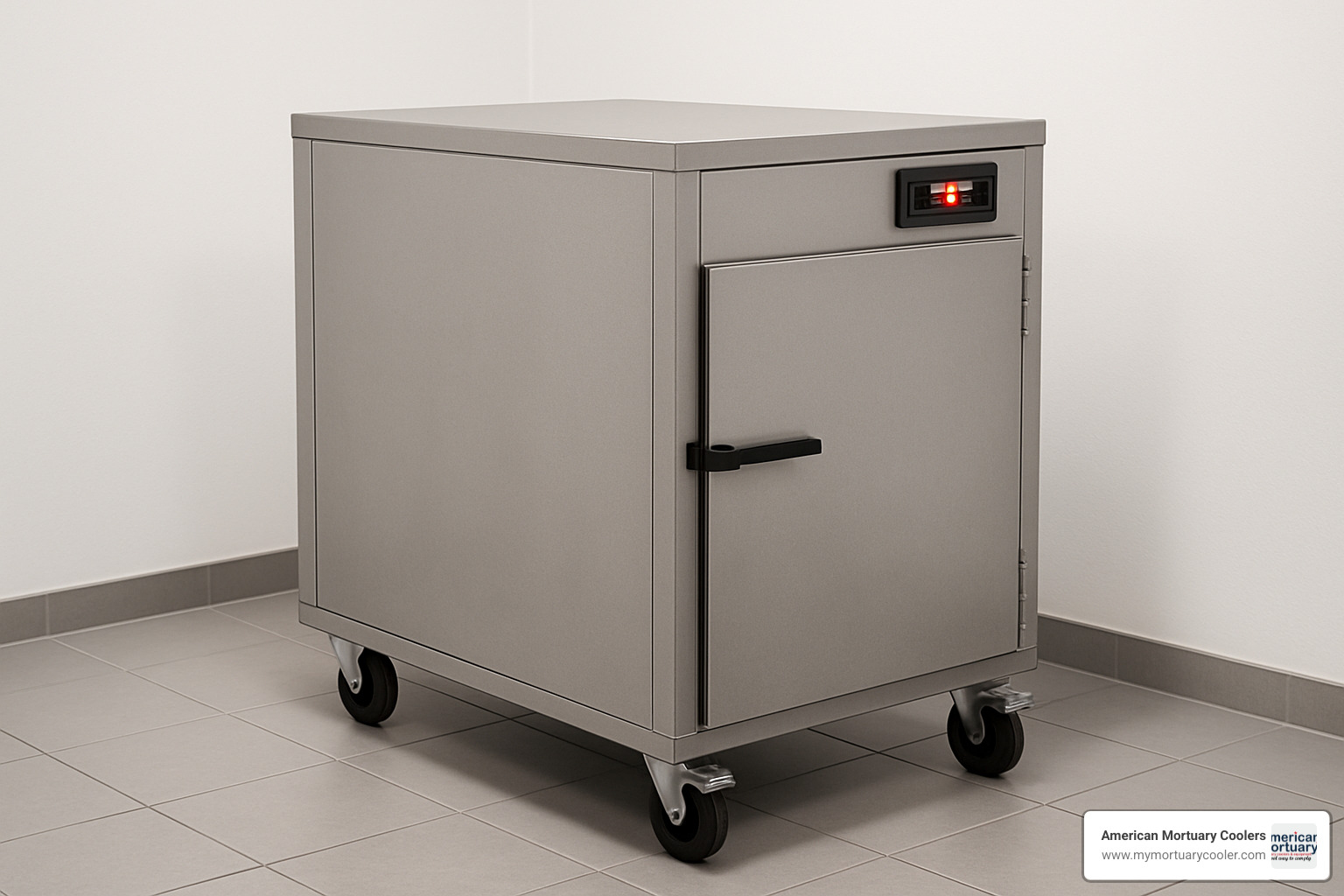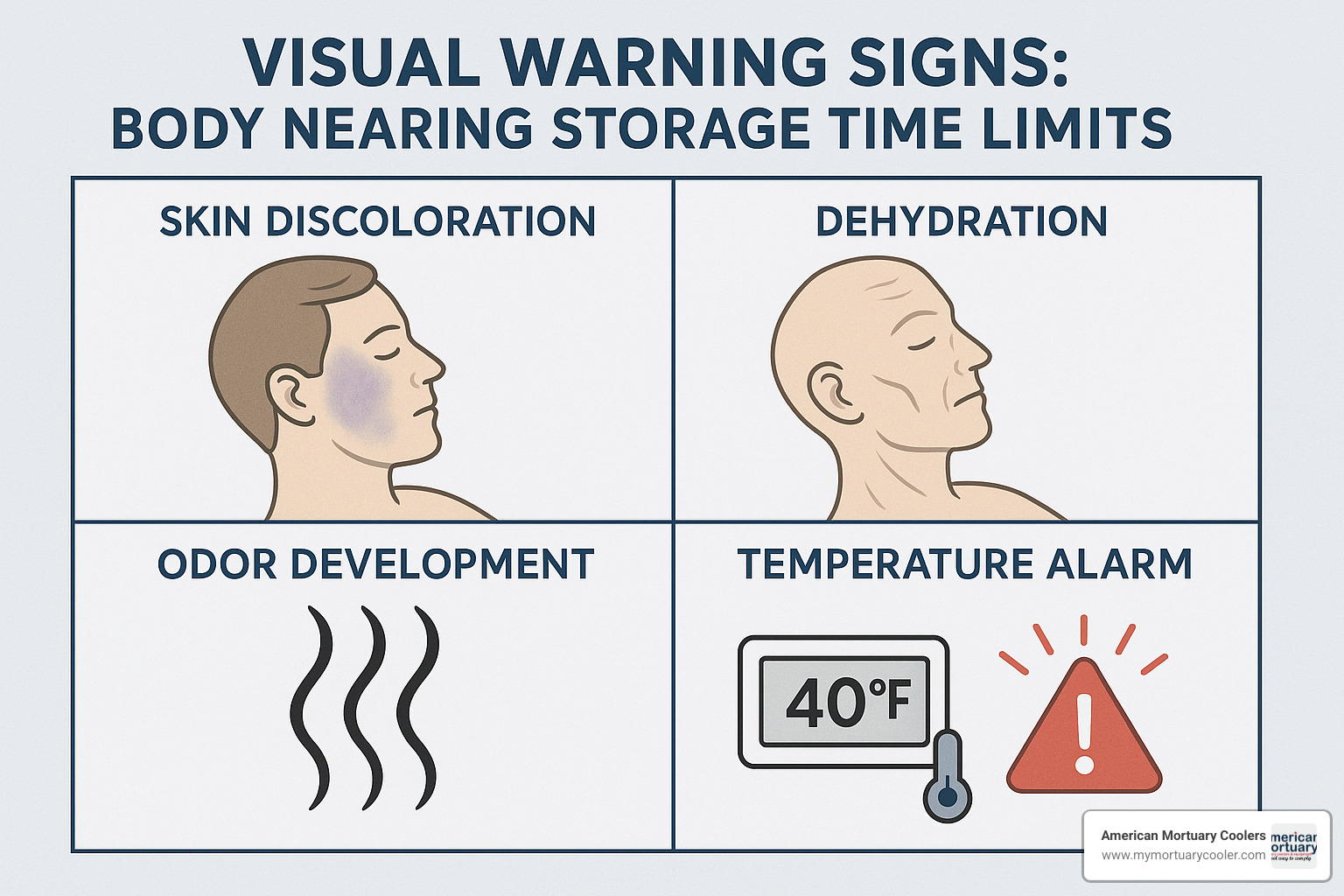
How to Determine Refrigeration Duration Before Cremation on a Budget
Why Understanding Refrigeration Timelines Matters for Your Funeral Home
When families ask how long can a body be refrigerated before cremation, the answer affects your scheduling, costs, and the care you provide. Getting it right means fewer rushed decisions and more dignified goodbyes.
Quick Answer:
- Typical refrigeration: 1–3 weeks at 35–40 °F
- Absolute maximum: Up to 4 weeks with tight temperature-humidity control
- Regulations differ: Some states mandate refrigeration within 24 h; others allow up to 8 days before cooling or embalming
- Ideal climate: 35–40 °F (2–4 °C) and 75–85 % RH
- Daily storage fees: About $25–75
Refrigeration is a chemical-free, budget-friendly alternative to embalming that can preserve remains long enough for travel, paperwork, and grief. Most facilities achieve three full weeks of safe storage; four is possible with commercial-grade equipment and vigilant monitoring.

Learn more:
Why This Guide Matters
Clear refrigeration policies let 95 % of families plan services without feeling rushed, and 60 % say eco-friendly options influence their choice of funeral home. Understanding timelines—and owning equipment that can reliably meet them—keeps your operation compliant, cost-effective, and compassionate.
Body Refrigeration 101: Purpose & Process
When someone passes away, funeral directors face an immediate challenge: how to preserve the body's dignity while giving families time to grieve and plan. Body refrigeration solves this problem by maintaining deceased remains at carefully controlled low temperatures - typically between 35-40°F - to dramatically slow the natural decomposition process.
Think of it like putting food in your refrigerator to keep it fresh, but with much more precision and care. Unlike freezing, which can damage delicate tissues, proper refrigeration keeps the body looking peaceful and natural for weeks.
Decomposition is a natural process that begins the moment life ends. Within just 24-72 hours at room temperature, cellular breakdown speeds up and families may notice visible changes. The science behind this process is fascinating yet sobering - understanding decomposition stages helps explain why temperature control is so critical.
Modern mortuary coolers are sophisticated pieces of equipment designed specifically for this delicate work. These units feature digital temperature displays with alarm systems that alert staff if temperatures fluctuate, backup power systems to prevent equipment failure during outages, and vapor-proof LED lighting that won't create heat.

The preservation goal is straightforward but crucial: maintain tissue integrity and natural appearance while preventing bacterial growth and odor formation. When done correctly, proper refrigeration extends the storage window from mere hours to several weeks.
Why Bodies Are Cooled Before Cremation
Public health protection drives most refrigeration requirements. Without proper temperature control, harmful bacteria can multiply rapidly, creating serious biohazard conditions within just 24-48 hours. State health departments understand this risk, which is why most require either refrigeration or embalming within this critical timeframe.
Modern families are scattered across the country, and coordinating everyone's travel for funeral services often takes much longer than people expect. Our experience shows that about 40% of families need at least 7-10 days to arrange services properly, while 15% require 2-3 weeks or more.
Permit delays add another layer of complexity that families rarely anticipate. Cremation requires multiple signatures, medical examiner clearances, and sometimes court orders if there are family disputes. These processes can stretch on for days or weeks, making reliable refrigeration essential.
Refrigeration vs. Embalming Overview
Chemical-free preservation appeals to growing numbers of families who worry about environmental impact. Refrigeration uses no formaldehyde or other toxic chemicals that can linger in groundwater or affect funeral home workers.
Green burial compatibility represents another significant advantage. Many natural burial grounds prohibit embalmed remains due to concerns about chemical contamination. Refrigeration preserves bodies beautifully for green burial without compromising environmental standards.
Cultural and religious considerations vary dramatically across different communities. Some faiths prohibit embalming completely, while others require burial within specific timeframes. Refrigeration provides the flexibility to honor these beliefs while maintaining practical storage capabilities.
How Long Can a Body Be Refrigerated Before Cremation?
When families ask how long can a body be refrigerated before cremation, the answer isn't always straightforward. Most funeral homes can safely store remains for 1-3 weeks under standard conditions, but this timeline depends on several important factors working together.
Bodies stored at the optimal 35-40°F range with proper humidity levels can remain in good condition for up to 4 weeks maximum. However, this extended timeline requires commercial-grade equipment and careful monitoring that not all facilities can provide.
The preservation timeline follows a predictable pattern. During the first week, bodies maintain excellent condition with minimal visible changes. Week two still offers good preservation when temperature stays consistent. By weeks three and four, you're pushing the limits and need ideal conditions plus daily monitoring.
Temperature control makes all the difference in determining how long refrigeration remains effective. Bodies stored above 40°F start showing decomposition signs much faster, while temperatures below 35°F risk tissue damage that affects appearance during services.
Humidity levels between 75-85% work alongside temperature to prevent problems. Too little humidity causes skin to shrink and change color. Too much moisture creates the perfect environment for bacterial growth.

Funeral home capacity often becomes the limiting factor regardless of how well your equipment works. Most facilities have 2-8 refrigeration spaces, which creates real constraints during busy periods. We've helped funeral homes increase their capacity by 300% through strategic equipment upgrades.
The reality is that how long can a body be refrigerated before cremation depends as much on your facility's capabilities as it does on the science of preservation. Having reliable backup power, proper monitoring systems, and enough space makes all the difference.
More info about morgue cooler temperatures provides detailed technical specifications for optimal preservation conditions.
Standard Timeline for how long can a body be refrigerated before cremation
The 3-14 day window represents what most funeral homes across America handle regularly. Our client data shows that 70% of cremations happen within this timeframe, with families typically scheduling services 5-10 days after death.
Extended storage of 21-28 days enters more specialized territory. Only facilities with commercial-grade refrigeration systems and backup power should attempt storage beyond three weeks. At this point, bodies need daily visual inspections and careful temperature logging.
Documentation requirements become more complex as storage time increases. Most states require written authorization for preservation beyond 72 hours. Some states mandate family consent for storage exceeding 10 days.
Comparing Refrigeration, Embalming, and Freezing
Shelf life varies dramatically between preservation methods. Refrigeration offers 1-4 weeks with gradual quality decline over time. Embalming extends this to 2-6 weeks with more stable appearance throughout. Freezing provides indefinite storage but damages tissues permanently.
Appearance considerations directly impact family viewing decisions. Refrigerated bodies maintain their natural appearance beautifully for 1-2 weeks but may show skin discoloration as time passes. Embalmed bodies retain cosmetic appearance longer but require chemical treatment. Frozen bodies suffer tissue damage that creates permanent changes.
Environmental impact matters increasingly to families making funeral decisions. Refrigeration uses electricity but introduces no chemicals into the environment. Embalming relies on toxic substances that can persist in soil and groundwater. Freezing requires more energy than refrigeration but remains chemical-free.
Influencing Factors & Legal Limits
When families ask how long can a body be refrigerated before cremation, several factors work together to determine the safe storage period. Understanding these variables helps funeral directors provide accurate guidance during difficult times.
Temperature control precision makes the biggest difference in preservation quality. Professional mortuary coolers that maintain steady 35-40°F temperatures can preserve bodies for the maximum duration, while units with temperature swings dramatically reduce safe storage time. Our monitoring data shows that temperature variations above just 5°F can cut safe storage time in half.
Humidity management works hand-in-hand with temperature control. When humidity drops below 70%, bodies dehydrate quickly, causing skin shrinkage and discoloration. Humidity above 90% creates conditions where bacteria thrive. The sweet spot of 75-85% humidity prevents both problems.
The condition of the body at time of death significantly influences how long refrigeration remains effective. Individuals who were healthy at death typically preserve well for the full 3-4 week period. However, those with certain medical conditions or infections may require shortened storage times.
Communicable disease protocols can completely override standard refrigeration timelines. Ohio law, for example, requires burial or cremation within 24 hours for bodies with communicable diseases, regardless of refrigeration capabilities.
Autopsy holds present unique challenges that can extend refrigeration requirements indefinitely. Medical examiner cases sometimes require weeks or months of storage while investigations proceed.
State laws create the legal framework that determines how long can a body be refrigerated before cremation in your specific location. While the Federal Trade Commission's Funeral Rule establishes baseline protections nationwide, individual states set their own requirements. Scientific research on funeral regulations provides comprehensive guidance on navigating these requirements.
Temperature & Humidity Benchmarks
The 35-40°F target temperature range represents years of industry experience finding the optimal balance between preservation and tissue integrity. Go below 35°F and you risk freezing damage. Allow temperatures above 40°F and decomposition accelerates rapidly.
Our technical team recommends maintaining 37-38°F for maximum preservation duration. This narrow range provides the longest safe storage while maintaining dignity for family viewings.
Alarm systems serve as your early warning system against equipment failures. Temperature alarms should trigger at 34°F (low) and 42°F (high) to provide time for corrective action. Humidity alarms at 65% (low) and 90% (high) prevent dehydration and bacterial growth.
Backup power systems ensure continuous refrigeration when the unexpected happens. Battery backup systems can maintain refrigeration for 4-8 hours during brief outages, while generators provide indefinite protection during extended power failures.
State-Specific Rules That Change how long can a body be refrigerated before cremation
Pennsylvania and New Jersey create some of the tightest timelines in the country, requiring refrigeration or embalming within 24 hours if burial or cremation cannot occur immediately. This narrow window affects planning for how long can a body be refrigerated before cremation.
North Dakota takes an even more restrictive approach, mandating disposition within 8 days and prohibiting refrigeration entirely for certain communicable diseases.
Oregon requires funeral homes to report any body held longer than 10 days to the state mortuary board. While this doesn't prohibit extended storage, it creates administrative oversight.
On the more flexible side, Connecticut, Delaware, Indiana, and Montana allow "reasonable time" for disposition without specific numerical limits.
Funeral-Home Policies & Paperwork
Death certificate requirements establish the legal foundation for body storage, typically requiring filing within 24-72 hours of death. This document authorizes refrigeration and creates the framework for everything that follows.
Cremation authorization forms require careful attention to detail, often including specific language about refrigeration duration. Some forms limit storage to specific timeframes, while others provide open-ended authorization.
Refrigeration fee structures vary dramatically between facilities and regions. Some funeral homes charge flat rates for the first week ($200-400), while others use daily rates ($25-75). Extended storage often incurs premium rates.
Budget-Friendly Preservation Strategies & Practical Tips
When families face unexpected costs during an already difficult time, smart funeral directors look for ways to manage expenses without compromising dignity. Understanding how long can a body be refrigerated before cremation helps you offer flexible, budget-conscious options.
Renting portable coolers has become a game-changer for many funeral homes during busy seasons. Instead of turning families away or rushing services, you can bring in additional cooling capacity when needed. Several manufacturers offer rental programs that include delivery, setup, and pickup.
Dry ice can work wonders for extending the effectiveness of older refrigeration units that might not maintain perfect temperatures. About 16 pounds per day can supplement cooling for an adult body, though you'll need proper ventilation and safety protocols.
Some rural funeral homes have found success with shared storage arrangements between neighboring facilities. When one funeral home has overflow capacity and another needs space, cooperative agreements benefit everyone.
Travel coordination with families often provides the biggest cost savings of all. When you help families understand timing options upfront, they can make informed decisions about service scheduling. Many families don't realize that waiting an extra week for out-of-town relatives might add several hundred dollars in storage fees.

Green burial families often have an advantage when it comes to storage timing. These services typically happen more quickly than traditional funerals - usually within 3-7 days - which naturally reduces refrigeration costs.
More info about choosing a funeral home cooler can help you evaluate whether your current equipment is meeting your families' needs cost-effectively.
Renting vs. Owning Cooling Equipment
The math on renting versus owning depends entirely on how often you need extra capacity. Daily rental costs typically run $50-150 for portable mortuary coolers, which might seem steep until you consider the alternative of purchasing a $15,000-30,000 permanent unit that sits empty most of the year.
For funeral homes that occasionally face overflow situations, renting makes perfect financial sense. But if you're regularly storing bodies for extended periods or frequently running out of space, ownership becomes more economical.
Delivery logistics can make or break rental arrangements. Urban funeral homes usually enjoy same-day delivery, while rural locations might wait 24-48 hours.
Warranty coverage actually favors rental in many situations. Rental equipment comes with full maintenance and repair coverage included in the daily rate. When you own equipment, service calls and parts replacement come out of your pocket.
Alternatives When Refrigeration Isn't Available
Sometimes refrigeration simply isn't an option, whether due to equipment failure, power outages, or facility limitations. Quick cremation scheduling can eliminate storage needs entirely, though it requires crematoriums willing to accommodate rush requests.
Many crematoriums offer expedited services within 24-48 hours for additional fees. This works particularly well for families who prefer immediate disposition without viewing services.
Light embalming provides a middle ground between full chemical preservation and refrigeration-only storage. This technique uses reduced chemical concentrations to preserve bodies for 5-10 days.
Water cremation is gaining popularity as an eco-friendly alternative that may have different storage requirements than traditional flame cremation. Step-by-Step Guide to the Water-Based Cremation Process explains how this technology works.
Questions to Ask Your Funeral Home
Storage duration policies should be crystal clear and communicated upfront. Temperature monitoring systems separate professional operations from amateur ones. Facilities should maintain continuous temperature logs and have alarm systems for equipment failures.
Overflow plans matter more than most people realize until they're needed. What happens when the funeral home is at capacity and another family needs services? Professional facilities have arrangements with other locations or rental companies to handle these situations smoothly.
Risks, Drawbacks, and When to Choose Other Options
While refrigeration is an excellent preservation method, extended storage comes with challenges that every funeral director should understand. Knowing these limitations helps you make better decisions for families and protects your facility from potential problems.
Tissue dehydration becomes the first noticeable issue after 10-14 days of refrigeration. Even with proper humidity control, skin will start to shrink and change color. This doesn't affect cremation outcomes, but it can be distressing for families who want to see their loved one one last time.
Odor development is probably every funeral director's biggest concern with extended refrigeration. Bodies stored beyond three weeks may develop noticeable smells even when temperature control is perfect. This creates real operational challenges for your staff and families visiting your facility.
Freezer burn happens when refrigeration temperatures accidentally drop below freezing. This usually results from equipment problems or incorrect temperature settings. The tissue damage is permanent and can't be fixed.
The emotional impact on families is something grief counselors often discuss with us. Some families find that extended storage makes it harder to accept their loss and move forward in the grief process.
Legal penalties for improper storage aren't just theoretical concerns. Funeral homes face real fines, license suspensions, and civil liability when storage goes wrong. The key is having proper documentation of your procedures and following all state regulations about how long can a body be refrigerated before cremation.

Signs Refrigeration Time Is Running Out
Experience teaches you to watch for specific warning signs that indicate preservation is declining. Skin slippage typically appears after 14-21 days and looks exactly like it sounds - the skin layers start separating or becoming loose.
Odor changes are often the first sign families and staff notice. The smell shifts from neutral to sweet or sour, indicating bacterial activity despite proper refrigeration. Any noticeable odor development means you should schedule cremation promptly.
Color shifts from natural skin tones to gray or green hues typically occur after 3-4 weeks of refrigeration. These changes signal that you've reached the maximum safe storage duration.
Switching to Embalming or Immediate Cremation
Sometimes you need to change course mid-stream. Equipment failure is the most common trigger for switching preservation methods. When your refrigeration system goes down, you have limited time to make alternative arrangements.
Extended storage needs beyond refrigeration capabilities also require method changes. If a family initially planned for one week but circumstances extend to three weeks, embalming might become the better option.
Cost considerations often surprise families. While embalming has higher upfront costs ($500-1,500), it may actually cost less than extended refrigeration fees for storage periods exceeding two weeks.
Family consent requirements vary by state but typically require written authorization for any preservation method changes. Having these conversations early prevents difficult decisions during crisis moments.
Frequently Asked Questions about Refrigeration Before Cremation
Does how long can a body be refrigerated before cremation vary by state?
How long can a body be refrigerated before cremation definitely changes depending on where your funeral home operates. State regulations create a patchwork of requirements that can catch funeral directors off guard.
Pennsylvania and New Jersey take a strict approach, requiring funeral homes to begin preservation within 24 hours of death. North Dakota represents the most restrictive approach with an 8-day maximum storage limit. They also prohibit refrigeration entirely for certain communicable diseases.
Reporting rules add another layer of complexity. Oregon requires funeral homes to notify the state mortuary board about any body held longer than 10 days. It's not a prohibition, but it does create paperwork and potential scrutiny.
On the opposite end, Connecticut allows "reasonable time" without putting a specific number on it. This gives funeral directors more flexibility but also requires professional judgment.
The key takeaway? Always check your state's specific requirements before committing to extended refrigeration periods. What works in one state might violate regulations in another.
What is the ideal temperature range for safe storage?
The sweet spot for mortuary refrigeration is 35-40°F with humidity maintained between 75-85%. This range slows decomposition effectively while avoiding the tissue damage that freezing can cause.
Think of it like storing food - too warm and bacteria multiply rapidly, too cold and you get freezer burn. Bodies react similarly to temperature extremes. Temperatures above 40°F let bacterial growth accelerate, while temperatures below 35°F risk permanent tissue damage.
Consistency matters more than perfection when it comes to temperature control. A unit that maintains steady 38°F will preserve bodies better than one that fluctuates between 35-40°F throughout the day. Temperature swings above 5°F can cut your safe storage time significantly.
Professional mortuary coolers include built-in monitoring systems that track both temperature and humidity continuously. These systems should alarm at 34°F (low) and 42°F (high) for temperature, plus 65% (low) and 90% (high) for humidity.
Are there health risks to families during extended refrigeration?
Properly refrigerated bodies pose minimal health risks to families during normal viewing and visitation activities. The controlled temperature environment prevents most bacterial growth that could create biohazard conditions.
However, extended storage beyond three weeks does increase some considerations. Bodies stored this long may develop subtle odors or bacterial activity that could affect air quality in viewing rooms. It's not typically dangerous, but it can be unpleasant.
Families with compromised immune systems deserve special consideration. Anyone undergoing chemotherapy, dealing with chronic illness, or otherwise immunocompromised should consult their healthcare provider before extended viewing periods.
The bigger risk is often emotional rather than physical. Some families find that extended storage periods complicate their grieving process by prolonging the time before final disposition.
Conclusion
Planning for how long can a body be refrigerated before cremation doesn't have to feel overwhelming. With the right knowledge and equipment, most funeral homes can confidently offer families the time they need - typically 1-3 weeks, extending to 4 weeks with optimal conditions.
After years of helping funeral directors across the country, I've seen how proper refrigeration transforms stressful situations into manageable ones. Families get the flexibility to coordinate travel, secure permits, and process their grief without feeling rushed through one of life's most important decisions.
At American Mortuary Coolers, we understand that every funeral home has unique needs. Whether you're a small family operation in rural Tennessee or a high-volume facility in downtown Chicago, we craft custom mortuary coolers that fit your space, budget, and service goals. Our equipment delivers the precision temperature control needed to maximize safe storage duration while maintaining dignity.
Reliable refrigeration equipment pays for itself through better family satisfaction and fewer emergency situations. When your cooler maintains consistent 35-40°F temperatures with proper humidity control, you can confidently tell families they have options. No more scrambling to find overflow storage or rushing families through decisions they're not ready to make.
We've delivered durable solutions directly to funeral homes in Tennessee, Georgia, Illinois, South Carolina, Texas, California, New York, and Pennsylvania - covering all 48 contiguous states. Our regional service network means you get local support with national expertise, whether you need a compact 2-body unit or a walk-in cooler for larger operations.
Respectful care extends far beyond the moment of death. Proper refrigeration ensures families can say goodbye on their timeline, not yours. This service represents one of the most meaningful ways funeral homes support communities during their darkest hours.
The funeral industry continues evolving toward more personalized, environmentally conscious services. Families increasingly prefer chemical-free preservation options that support green burial choices. Having reliable refrigeration capabilities positions your funeral home to meet these changing preferences while maintaining operational flexibility.
More info about mortuary cooler requirements provides comprehensive guidance for selecting equipment that meets your facility's specific needs and local regulations.
Contact our team today to discuss how our custom mortuary coolers can improve your capabilities and better serve families in your community. With service centers spanning from our Johnson City, Tennessee headquarters across the Midwest, Northeast, Southeast, Southwest, Rocky Mountain, and Pacific regions, we're positioned to support your refrigeration needs wherever you're located.



